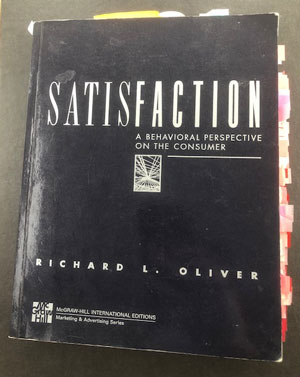“We want to know whether our customers are satisfied”. That’s the start of so many meetings I go to about survey design, and I’ve seen so many surveys that ask about it.
And many of us are far too familiar with survey invitations like thie one in this screenshot, that ask us to rate something by – in this case, visiting a shop.
I’ve written a few things about satisfaction
If you’d like to jump straight into some practical advice on asking about satisfaction, I’d ideally like you to buy my book Surveys that work, and read the Spotlight that I wrote in it about measuring satisfaction. Bonus: you get rather a lot of extra stuff about surveys, too.
While you wait for your copy to arrive, here’s a blog post that is somewhat similar:
And if you’d prefer to jump directly into some slides, these two presentations eac include a section on satisfaction
- Six crucial survey concepts that UX professionals need to know (Satisfaction is a slippery topic)
- Total survey error for non-specialists – creating better conversations (Satisfaction and Total Survey Error)
If you’d prefer to dive into the original sources, keep reading.
Satisfaction is an attitude that can be measured
My view is that satisfaction is an attitude – a complex concept in its own right, but it is definitely possible to measure attitudes.
I started to learn this in the first book that I read in depth on survey design: Oppenheim, A. N. (1992). Questionnaire design, interviewing and attitude measurement. London, Pinter Publishers Ltd, which I devoured in 2001. Does that make it seem that attitude measurement goes back a long way? Well, that’s nothing. The book I read is an extensively updated version of the original, published in 1966. That’s over 30 years after Rensis Likert’s famous 1932 paper A Technique for the Measurement of Attitudes.” Archives of Psychology 140: 55. And Likert was himself responding to previous papers. (Yes, that’s the same Likert whose name became associated with the LIkert Scale).
Given that the history of attitude measurement is a very long one, I’m going to limit the references that I give you to those two plus one more book that is specifically about constructing questions for attitude measurement: Schuman, H. and S. Presser (1996). Questions and answers in attitude surveys : experiments on question form, wording, and context. Thousand Oaks ; London, Sage.I liked that book so much that I wrote this:
- Questions and answers in attitude surveys – a review of the book
It used to be difficult to find Likert’s paper online, which is why it seems to me to be cited considerably more often than it is read, but these days there are quite a few scans available with a little searching for those of us who do not have access to an academic library. If you do have academic access, your librarian will be able to get an official copy for you.
The other two books are widely available in libraries or second hand.
Satisfaction is a complex attitude

Let’s have a look at satisfaction specifically. In my Spotlight and my talks, I explain how our satisfaction with something can change in a flash.
For example, recently I was delighted to win a beautiful silver ring in an online auction for what I thought was a good price. I decided to look up the maker online, and discovered that I could have purchased one directly from them for a bit less than I paid in the auction. I still love the ring, but my satisfaction is now tinged with regret that I didn’t do the searching properly before I bid.
Another book I read in 2001 was the 1996 edition of Richard L. Oliver’s “Satisfaction: A behavioral perspective on the consumer”. I took it on holiday and focused on it for a week. I can’t pretend that it was an easy read, but it was compelling – my battered copy has a forest of index tabs sticking out of it, and a pile of sticky notes inside the back flap where I attached follow-up thoughts and ideas.
if you want to engage seriously with the topic of satisfaction, my strong recommendation is to get hold of the second edition. Every chapter concludes with dozens of references that will provide the basis of any literature search that you might wish to do.

